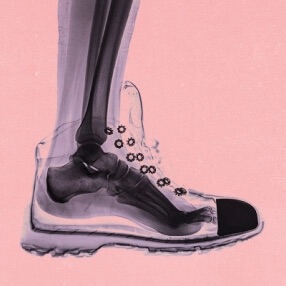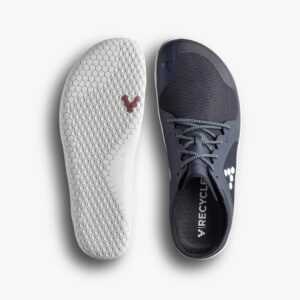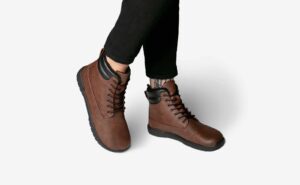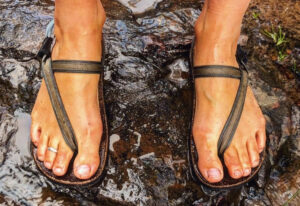Foot health is foundational to athletic performance, yet it’s often overlooked until issues arise. For athletes—especially those in martial arts, running, climbing, or endurance sports—the feet play a critical role in strength, balance, and overall movement efficiency. Modern footwear, however, has disrupted the natural function of our feet, leading to weakness, pain, and even chronic injury.
This comprehensive guide explores the science of foot health, the harm caused by conventional shoes, the transformative benefits of minimalist footwear, and actionable strategies for rebuilding strong, functional feet. We’ll also provide our top recommendations for barefoot and minimalist footwear to help you take the first steps toward restoring your foundation for optimal performance.
The Evolutionary Genius of the Human Foot
The human foot is a marvel of engineering, evolved over millions of years to meet the demands of dynamic movement across diverse terrains. Its 26 bones, 33 joints, and over 100 muscles and tendons form a system that provides stability, shock absorption, and balance. Before the advent of modern footwear, our ancestors relied on bare feet or simple protective coverings, allowing the foot’s natural mechanics to shine.
However, today’s lifestyle disconnects us from this evolutionary design. Walking on flat, hard surfaces while wearing rigid, cushioned shoes dulls sensory feedback, weakens foot muscles, and causes misalignment. Several studies have demonstrated that modern shoes significantly impair foot flexibility and reduce proprioception, leading to inefficient movement and higher injury risk.
By returning to more natural movement patterns and footwear, we can rediscover the strength and resilience our ancestors took for granted.
The Silent Epidemic: How Conventional Footwear Weakens Us
 Modern footwear is designed for aesthetics and immediate comfort, often sacrificing long-term health. Common features like narrow toe boxes, elevated heels, and thick soles distort natural foot mechanics and contribute to widespread dysfunction:
Modern footwear is designed for aesthetics and immediate comfort, often sacrificing long-term health. Common features like narrow toe boxes, elevated heels, and thick soles distort natural foot mechanics and contribute to widespread dysfunction:
- Bunions and Deformities: Narrow toe boxes compress toes, causing issues like hammer toes and bunions.
- Plantar Fasciitis: Overly cushioned shoes weaken the arches, leading to chronic heel pain.
- Poor Posture: Elevated heels shift weight forward, straining the knees, hips, and lower back.
Footwear has been a fundamental part of human culture for centuries, but it has also contributed to an underrecognized public health issue: the systematic weakening and deformation of the human foot. Despite technological advancements in footwear design, the prevalence of foot pain and dysfunction continues to rise, with over 77% of Americans reporting foot-related problems.
This issue is neither new nor mysterious. The detrimental effects of ill-fitting footwear have been documented as far back as ancient Greece, where philosophers like Socrates advocated for walking barefoot to avoid foot deformities. By the 1800s, European physicians were publishing research on the harmful effects of narrow, restrictive shoes, highlighting how they distorted foot structure and impaired movement. Dr. Philip Hoffman, in 1905, conducted comparative studies that showed traditional shoes deform feet, a problem that persists in modern footwear.
A Modern Vulnerability Rooted in History
Foot health began to significantly decline with the advent of industrialized footwear in the 19th and 20th centuries. Modern shoes, designed more for fashion and perceived comfort than functionality, introduced narrow toe boxes, rigid soles, and raised heels. While these features became societal norms, their consequences for foot health were severe.
A study in South Africa compared the feet of modern populations to 2,000-year-old skeletons, revealing that individuals who lived before the advent of shoes had stronger, healthier feet. Similarly, researchers found that children who grew up barefoot had better foot arches, straighter toes, and fewer deformities than their shoe-wearing counterparts.
Even the most advanced modern footwear has failed to resolve these issues. The proliferation of cushioned running shoes in the 1970s, intended to reduce injuries, paradoxically coincided with an increase in lower limb injuries. Data shows that up to 74% of recreational runners experience injuries annually, with many attributed to biomechanical changes caused by overly cushioned footwear.
How Modern Shoes Distort Natural Movement
The fundamental problem with most modern footwear lies in its interference with the natural mechanics of the foot.
-
Narrow Toe Boxes: These constrict the toes, leading to deformities such as bunions, hammer toes, and claw toes. A study by Dr. Shine in 1965 found that the longer an individual wore narrow shoes, the more pronounced their big toe angle became.
-
Elevated Heels: Raised heels shift weight forward, altering posture and placing strain on the knees, hips, and lower back. This artificial tilt disrupts the natural alignment of the skeletal system.
-
Thick Soles: Excessive cushioning under the heel encourages a heel-strike gait, which generates greater impact forces that travel up the leg and into the hips and spine.
-
Arch Support: While marketed as beneficial, arch support inhibits natural pronation—a key shock absorption mechanism—and weakens the intrinsic muscles of the foot.
Over time, these features cause muscles in the feet to weaken, reducing their ability to support body weight and absorb impact. They also impair proprioception—the body’s sense of spatial orientation—which is critical for balance and agility.
Barefoot: A Return to Natural Mechanics
The contrast between shod and unshod populations is striking. Numerous studies highlight the benefits of barefoot movement and minimalist footwear:
- Improved Foot Strength: A study at the University of Liverpool found that individuals wearing minimalist shoes experienced significant increases in foot muscle strength over just eight weeks.
- Reduced Injury Risk: Barefoot running encourages a forefoot or midfoot strike, reducing impact forces and promoting efficient movement.
- Better Balance and Mobility: Children who grow up barefoot score higher on tests of balance and motor skills compared to those who wear shoes regularly.
Even for older adults, minimalist footwear has proven beneficial. Research shows that it enhances stability and physical function, reducing the risk of falls—a critical concern as we age.
Rethinking Comfort: Marketing Myths vs. Reality
Modern shoe marketing has conditioned us to equate comfort with excessive cushioning and support. However, true comfort stems from functional, healthy feet that are strong, flexible, and well-aligned. Studies suggest that cushioned shoes may actually increase the risk of injury by encouraging inefficient movement patterns.
The natural arch of the foot, supported by the Achilles tendon, is designed to absorb and recoil over half of the energy generated during walking and running. Thick soles and arch supports disable this mechanism, making the body more reliant on external supports.
The Minimalist Solution: Footwear That Frees Your Feet
Minimalist footwear is designed to mimic the barefoot experience, allowing your feet to function as nature intended while protecting them from environmental hazards. These shoes share several key features:
- Wide Toe Boxes: Create space for natural toe splay, improving balance and reducing deformities.
- Zero-Drop Soles: Keep the heel and forefoot level, promoting alignment and reducing joint strain.
- Thin, Flexible Soles: Provide sensory feedback essential for efficient movement and balance.
Let’s take an in-depth look at how three leading minimalist footwear brands are transforming foot health and performance.
Brand Spotlight: Vivo Barefoot
 Vivo Barefoot has earned its reputation as a leader in minimalist footwear by combining cutting-edge science with a commitment to sustainability. Research led by Dr. Kris D’Aout showed that wearing Vivo Barefoot shoes for just six months improved foot strength by 60% and enhanced balance and mobility.
Vivo Barefoot has earned its reputation as a leader in minimalist footwear by combining cutting-edge science with a commitment to sustainability. Research led by Dr. Kris D’Aout showed that wearing Vivo Barefoot shoes for just six months improved foot strength by 60% and enhanced balance and mobility.
Why Vivo Barefoot Stands Out
- Wide Toe Boxes: Allow toes to spread naturally, reducing pressure and improving stability.
- Zero-Drop Soles: Promote upright posture and healthy joint mechanics.
- Eco-Friendly Materials: Vivo Barefoot uses recycled and sustainable materials, minimizing environmental impact.
These shoes are ideal for athletes and anyone seeking to improve foot health while staying connected to nature.
Brand Spotlight: Feelgrounds

Feelgrounds has redefined minimalist footwear by combining function and fashion. Their stylish designs appeal to those looking for an everyday barefoot experience without compromising aesthetics.
What Makes Feelgrounds Unique
- Toe Freedom: An anatomically shaped toe box prevents conditions like bunions and claw toes.
- Flat, Flexible Soles: Encourage natural movement and improve balance.
- Sustainability: Made from vegan and recycled materials, Feelgrounds aligns with environmentally conscious values.
Feelgrounds bridges the gap between performance and style, making minimalist footwear accessible to a wide audience.
Brand Spotlight: Earth Runners

Earth Runners sandals go a step further by incorporating grounding technology. Inspired by the huarache sandals of the Tarahumara tribe, Earth Runners connect wearers to the earth’s natural electromagnetic frequencies, promoting physical and mental health.
Why Earth Runners Are Revolutionary
- Grounded Conductive Lacing System™: Copper plugs and stainless steel threads enable grounding, reducing inflammation and regulating circadian rhythms.
- Minimalist Design: Flexible, zero-drop soles encourage natural movement and strengthen foot muscles.
- Sustainability: Built with eco-friendly materials, these sandals are perfect for nature enthusiasts.

Whether you’re trail running, hiking, or simply reconnecting with the earth, Earth Runners sandals offer unparalleled benefits.
Rebuilding Foot Strength
Transitioning to minimalist footwear is a powerful step, but rebuilding foot strength requires consistent effort. Incorporate these practices into your routine to restore your feet to their natural state:
1. Toe Isolation Exercises
- Lift and spread each toe individually to strengthen the intrinsic foot muscles.
2. Foot Rolling
- Use a massage ball to release tension and improve circulation in the arches.
3. Dynamic Stretching
- Focus on the calves, Achilles tendons, and plantar fascia to enhance flexibility and prevent tightness.
4. Balance Training
- Practice standing on one foot or using a wobble board to improve proprioception and stability.
5. Barefoot Walking
- Gradually expose your feet to natural surfaces like grass, sand, or dirt to rebuild strength and adaptability.
The Forgotten Sense: Sensory Feedback
The soles of your feet are rich with nerve endings that provide critical sensory feedback to the brain. This feedback is essential for balance, coordination, and efficient movement. However, thick-soled shoes mute these signals, reducing your body’s ability to respond to changes in terrain.
Minimalist footwear restores this connection, allowing you to move with greater precision and confidence.
The Kinetic Chain: How Foot Health Impacts the Body
Your feet are the foundation of the kinetic chain—a system of interconnected joints and muscles. Weak or misaligned feet can cause compensatory issues throughout the body, including:
- Knee Pain: Poor foot mechanics increase strain on the knees.
- Hip Misalignment: Weak arches can lead to instability in the hips.
- Postural Imbalances: Elevated heels disrupt natural alignment, affecting the spine and shoulders.
Transitioning to Minimalist Footwear
Switching to minimalist shoes requires patience and a gradual approach. Follow these steps to ensure a smooth transition:
- Start Slowly: Wear minimalist shoes for short periods and increase gradually.
- Incorporate Exercises: Strengthen your feet with targeted exercises.
- Choose Soft Surfaces: Begin walking on grass or sand before harder terrains.
- Listen to Your Body: Allow time for recovery if soreness occurs.
Conclusion: Reclaiming Your Foundation
Your feet are the foundation of your body, and their health impacts everything from athletic performance to overall mobility. By understanding the natural mechanics of the foot, choosing minimalist footwear, and committing to foot-strengthening practices, you can unlock your body’s full potential.
Whether you opt for Vivo Barefoot’s science-backed designs, Feelgrounds’ stylish versatility, or Earth Runners’ grounding technology, the path to stronger, healthier feet starts today.








